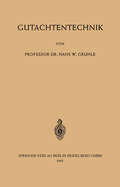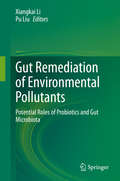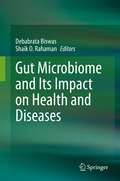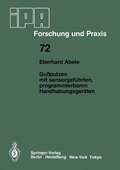- Table View
- List View
H (Systems & Control: Foundations & Applications)
by Basar BernhardOne of the major concentrated activities of the past decade in control theory has been the development of the so-called "HOO-optimal control theory," which addresses the issue of worst-case controller design for linear plants subject to unknown additive disturbances, including problems of disturbance attenuation, model matching, and tracking. The mathematical OO symbol "H " stands for the Hardy space of all complex-valued functions of a complex variable, which are analytic and bounded in the open right half complex plane. For a linear (continuous-time, time-invariant) plant, oo the H norm of the transfer matrix is the maximum of its largest singular value over all frequencies. OO Controller design problems where the H norm plays an important role were initially formulated by George Zames in the early 1980's, in the context of sensitivity reduction in linear plants, with the design problem posed as a mathematical optimization problem using an (HOO) operator norm. Thus formulated originally in the frequency domain, the main tools used during the early phases of research on this class of problems have been operator and approximation theory, spectral factorization, and (Youla) parametrization, leading initially to rather complicated (high-dimensional) OO optimal or near-optimal (under the H norm) controllers.
A Gyrovector Space Approach to Hyperbolic Geometry (Synthesis Lectures on Mathematics & Statistics)
by Abraham UngarThe mere mention of hyperbolic geometry is enough to strike fear in the heart of the undergraduate mathematics and physics student. Some regard themselves as excluded from the profound insights of hyperbolic geometry so that this enormous portion of human achievement is a closed door to them. The mission of this book is to open that door by making the hyperbolic geometry of Bolyai and Lobachevsky, as well as the special relativity theory of Einstein that it regulates, accessible to a wider audience in terms of novel analogies that the modern and unknown share with the classical and familiar. These novel analogies that this book captures stem from Thomas gyration, which is the mathematical abstraction of the relativistic effect known as Thomas precession. Remarkably, the mere introduction of Thomas gyration turns Euclidean geometry into hyperbolic geometry, and reveals mystique analogies that the two geometries share. Accordingly, Thomas gyration gives rise to the prefix "gyro" that is extensively used in the gyrolanguage of this book, giving rise to terms like gyrocommutative and gyroassociative binary operations in gyrogroups, and gyrovectors in gyrovector spaces. Of particular importance is the introduction of gyrovectors into hyperbolic geometry, where they are equivalence classes that add according to the gyroparallelogram law in full analogy with vectors, which are equivalence classes that add according to the parallelogram law. A gyroparallelogram, in turn, is a gyroquadrilateral the two gyrodiagonals of which intersect at their gyromidpoints in full analogy with a parallelogram, which is a quadrilateral the two diagonals of which intersect at their midpoints. Table of Contents: Gyrogroups / Gyrocommutative Gyrogroups / Gyrovector Spaces / Gyrotrigonometry
Gyrotrons: High-Power Microwave and Millimeter Wave Technology (Advanced Texts in Physics)
by Machavaram V. Kartikeyan Edith Borie Manfred ThummDrawing on the author's wide experience, this book gives a comprehensive review of the state of the art in gyrotron technology, covering the theory, design and applications. The book includes an extensive references list which provides an excellent guide to the related literature.
Gyros, Clocks, Interferometers…: Testing Relativistic Gravity in Space (Lecture Notes in Physics #562)
by C. Lämmerzahl C. W. F. Everitt F. W. HehlMany new tests of gravity and, in particular, of Einstein's general relativity theory will be carried out in the near future: The Lense--Thirring effect and the equivalence principle will be tested in space; moreover, gravitational waves will be detected, and new atomic interferometers and clocks will be built for measurements in gravitational and inertial fields. New high-precision devices have made these experiments feasible. They will contribute to a better understanding of gravitational physics. Both experimental developments and the theoretical concepts are collected in this volume. Exhaustive reviews give an overall insight into the subject of experimental gravitation.
Gyrodynamics: Course held at the Department of General Mechanics, October 1970 (CISM International Centre for Mechanical Sciences #53)
by K. MagnusGyro-Free Inertial Navigation Technology (Navigation: Science and Technology #7)
by Hongjin Zhou Yunhai Zhong Hui Song Su WangThis book focuses on gyro-free inertial navigation technology, which is used to measure not only linear motion parameters but also angular rates. Since no gyroscopes are used, the key technologies, such as initial alignment, attitude resolution, and error calibration, are very different than those used in traditional methods.Discussing each key technology in gyro-free inertial navigation system (GFINS) manufacture in a separate chapter, the book features easy-to-understand, detailed illustrations, to allow all those involved in inertial navigation to gain a better grasp of GFINS manufacture, including accelerometer setting principles; initial alignment; quaternion-based, attitude resolution algorithms; and accelerometer de-noise methods.
Gypsum & Gypsum Products: Their Science & Technology
by Manjit SinghHighly detailed and elaborate, this book is written explicitly for the purpose of professionals who work with gypsum in various technical and consumer-centric fields. It emphasises technical specifications of gypsum and associated products focusing on particular applications in industries such as construction, decoration, medicine, dentistry, architecture, chemical product manufacturing, arts, cooking, cosmetics, and agriculture. The book takes into account different chemical, physical, and biological characteristics and the relevance of gypsum and its extended applications.
Gypsum & Gypsum Products: Their Science & Technology
by Manjit SinghHighly detailed and elaborate, this book is written explicitly for the purpose of professionals who work with gypsum in various technical and consumer-centric fields. It emphasises technical specifications of gypsum and associated products focusing on particular applications in industries such as construction, decoration, medicine, dentistry, architecture, chemical product manufacturing, arts, cooking, cosmetics, and agriculture. The book takes into account different chemical, physical, and biological characteristics and the relevance of gypsum and its extended applications.
The Gymnosperms
by Chhaya Biswas B.M. JohriThe Gymnosperms is a well-illustrated comprehensive account of living and fossil plants of this group. Chapters 1 and 2 give a general account, and describe similarities and dissimilarities with pteridophytes and angiosperms. Chapter 3 deals with classification. The next 18 chapters (4-21) deal sequentially with fossil and living taxa. Phylogenetic relationships are considered for each order. Chapter 22 discusses the in vitro experimental studies on the growth, development and differentiation of vegetative and reproductive organs and tissues. Chapter 23 summarizes the economic importance of gymnosperms. Chapter 24 gives the conciuding remarks. Thus, there is a complete coverage of significant findings concerning morphology, anatomy, reproduction, development of embryo and seed, cytology, and -evolutionary trends and phylogeny. Ultrastructural and histochemical details are given wherever considered necessary. There is a comprehensive list of literature citations, and a plant index. This book is essentially meant for the postgraduate students in India and abroad. Undergraduate students can also use it profitably. The entire course should be taught in 25-30 lectures/hours and about 75 hours of field and laboratory work.
Güteeigenschaften keramischer Wand- und Bodenfliesen und deren Prüfmethoden (Forschungsberichte des Wirtschafts- und Verkehrsministeriums Nordrhein-Westfalen #266)
by Fliesen-Beratungsstelle Bad MehlemGutachten über die Elektrifizierung der Strecke Wien —Salzburg: Erstattet an den Herrn Bundesminister für Handel und Verkehr von dem hiezu bestellten Sachverständigenkollegium
by Robert FindeisDieser Buchtitel ist Teil des Digitalisierungsprojekts Springer Book Archives mit Publikationen, die seit den Anfängen des Verlags von 1842 erschienen sind. Der Verlag stellt mit diesem Archiv Quellen für die historische wie auch die disziplingeschichtliche Forschung zur Verfügung, die jeweils im historischen Kontext betrachtet werden müssen. Dieser Titel erschien in der Zeit vor 1945 und wird daher in seiner zeittypischen politisch-ideologischen Ausrichtung vom Verlag nicht beworben.
Gutachten des Reichs-Gesundheitsrats über den Einfluß der Ableitung von Abwässern aus der Chlorkalium- und Sulfatfabrik der Gewerkschaft Rastenberg in Rastenberg i. Thüringen auf die Ilm, Lossa und Saale (Arbeiten aus dem Kaiserlichen Gesundheitsamte)
by Karl Fränken Hermann Keller Oscar SpittaDieser Buchtitel ist Teil des Digitalisierungsprojekts Springer Book Archives mit Publikationen, die seit den Anfängen des Verlags von 1842 erschienen sind. Der Verlag stellt mit diesem Archiv Quellen für die historische wie auch die disziplingeschichtliche Forschung zur Verfügung, die jeweils im historischen Kontext betrachtet werden müssen. Dieser Titel erschien in der Zeit vor 1945 und wird daher in seiner zeittypischen politisch-ideologischen Ausrichtung vom Verlag nicht beworben.
Gutachten des Reichs-Gesundheitsrats, betreffend die Abwässerbeseitigung der Stadt Offenbach a. Main (Arbeiten aus dem Kaiserlichen Gesundheitsamte)
by Karl B. Lehmann Hermann Keller Oscar SpittaDieser Buchtitel ist Teil des Digitalisierungsprojekts Springer Book Archives mit Publikationen, die seit den Anfängen des Verlags von 1842 erschienen sind. Der Verlag stellt mit diesem Archiv Quellen für die historische wie auch die disziplingeschichtliche Forschung zur Verfügung, die jeweils im historischen Kontext betrachtet werden müssen. Dieser Titel erschien in der Zeit vor 1945 und wird daher in seiner zeittypischen politisch-ideologischen Ausrichtung vom Verlag nicht beworben.
Gutachten betreffend Städtecanalisation und Verfahren für Abwässer-Reinigung
by Adolf Louis SchmidtmannGut Remediation of Environmental Pollutants: Potential Roles of Probiotics and Gut Microbiota
by Xiangkai Li Pu LiuThis book focuses on probiotics and gut microbiota, as well as their roles in alleviating the toxicity of various environmental pollutants, presenting the latest research findings and explaining advanced research methods and tools. At the same time, it offers suggestions for future research directions. Further, the book introduces readers to the concept of gut remediation, a potential approach to reducing environmental-pollutant toxicity in vivo, based on modulation of gut microbiota using probiotic supplements. Lastly it provides suggestions for further reading.
Gut Microbiota, Immunity, and Health in Production Animals (The Microbiomes of Humans, Animals, Plants, and the Environment #4)
by Michael H. Kogut Glenn ZhangThis work sheds new light on the interplay between the gut, gut microbiota, and host physiological processes in production animals.The gut microbiome shapes health and susceptibility to disease and has become a leading area of research in the animal sciences. Gut health encompasses a number of physiological and functional features. Nutrient digestion and absorption, host metabolism and energy generation, a stable microbiome, mucus layer development, barrier function, and mucosal immune responses; all of which are required to interact to make an animal perform physiologically and according to its greatest genetic potential.This carefully presented book broadens our vision, approach and results on gut health and the ability to regulate animal production. Understanding the chemistry of microbiomes has broad implications, including providing functional annotations for the microbial genomes, insights into the chemical languages that link microbes to each other and to their host, and translational implications for precision veterinary medicine, environmental health, and sustainable animal agriculture and welfare. Experts working in microbiome research, host immunity, and animal production, veterinarians and researchers in livestock science will understand the great importance of this volume.
Gut Microbiome and Its Impact on Health and Diseases
by Debabrata Biswas Shaik O. RahamanThis book provides a comprehensive examination of the role of gut microbiome/microflora in nutrition, metabolism, disease prevention and health issues, including farm animal health and food value, and human gastrointestinal health and immunity. Indigenous microbiotas, particularly the gut microflora/microbiome, are an essential component in the modern concept of human and animal health. The diet and lifestyle of the host and environment have direct impact on gut microflora and the patterns of gut microbial colonization associated with health and diseases have been documented.Contributing authors cover the impact of gut microbiome in farm animal health, and explore the possibility of modulating the human gut microbiome with better animal products to prevent human diseases, including endemic and emerging diseases such as obesity, cancer and cardiac diseases. Dieting plan and control methods are examined, with attention paid to balance dieting with natural food and drink components. In addition, the role of gut microbiota in enteric microbial colonization and infections in farm animals is also discussed.The volume also explores the possibility of improving human health by modulating the microbiome with better food, including bio-active foods and appropriate forms of intake. Throughout the chapters, authors examine cutting edge research and technology, as well as future directions for better practices regarding emerging issues, such as the safety and production of organic food.
Gut environment of pigs
by A PIVAThis book brings together in one volume recent knowledge of mechanisms which determines the ability of the gastrointestinal tract to withstand damage that potentially may be aimed against it. Also, the use of feed additives and probiotias alternatives to antibiotias growth promoters, safety aspects on non-use of antibiotias well as the current status of the use of antibiotiand probiotiin the EU is discussed.
Gusto for Things: A History of Objects in Seventeenth-Century Rome
by Renata AgoWe live in a material world—our homes are filled with things, from electronics to curios and hand-me-downs, that disclose as much about us and our aspirations as they do about current trends. But we are not the first: the early modern period was a time of expanding consumption, when objects began to play an important role in defining gender as well as social status. Gusto for Things reconstructs the material lives of seventeenth-century Romans, exploring new ways of thinking about the meaning of things as a historical phenomenon. Through creative use of account books, inventories, wills, and other records, Renata Ago examines early modern attitudes toward possessions, asking what people did with their things, why they wrote about them, and how they passed objects on to their heirs. While some inhabitants of Rome were connoisseurs of the paintings, books, and curiosities that made the city famous, Ago shows that men and women of lesser means also filled their homes with a more modest array of goods. She also discovers the genealogies of certain categories of things—for instance, books went from being classed as luxury goods to a category all their own—and considers what that reveals about the early modern era. An animated investigation into the relationship between people and the things they buy, Gusto for Things paints an illuminating portrait of the meaning of objects in preindustrial Europe.
Gusto for Things: A History of Objects in Seventeenth-Century Rome
by Renata AgoWe live in a material world—our homes are filled with things, from electronics to curios and hand-me-downs, that disclose as much about us and our aspirations as they do about current trends. But we are not the first: the early modern period was a time of expanding consumption, when objects began to play an important role in defining gender as well as social status. Gusto for Things reconstructs the material lives of seventeenth-century Romans, exploring new ways of thinking about the meaning of things as a historical phenomenon. Through creative use of account books, inventories, wills, and other records, Renata Ago examines early modern attitudes toward possessions, asking what people did with their things, why they wrote about them, and how they passed objects on to their heirs. While some inhabitants of Rome were connoisseurs of the paintings, books, and curiosities that made the city famous, Ago shows that men and women of lesser means also filled their homes with a more modest array of goods. She also discovers the genealogies of certain categories of things—for instance, books went from being classed as luxury goods to a category all their own—and considers what that reveals about the early modern era. An animated investigation into the relationship between people and the things they buy, Gusto for Things paints an illuminating portrait of the meaning of objects in preindustrial Europe.
Gusto for Things: A History of Objects in Seventeenth-Century Rome
by Renata AgoWe live in a material world—our homes are filled with things, from electronics to curios and hand-me-downs, that disclose as much about us and our aspirations as they do about current trends. But we are not the first: the early modern period was a time of expanding consumption, when objects began to play an important role in defining gender as well as social status. Gusto for Things reconstructs the material lives of seventeenth-century Romans, exploring new ways of thinking about the meaning of things as a historical phenomenon. Through creative use of account books, inventories, wills, and other records, Renata Ago examines early modern attitudes toward possessions, asking what people did with their things, why they wrote about them, and how they passed objects on to their heirs. While some inhabitants of Rome were connoisseurs of the paintings, books, and curiosities that made the city famous, Ago shows that men and women of lesser means also filled their homes with a more modest array of goods. She also discovers the genealogies of certain categories of things—for instance, books went from being classed as luxury goods to a category all their own—and considers what that reveals about the early modern era. An animated investigation into the relationship between people and the things they buy, Gusto for Things paints an illuminating portrait of the meaning of objects in preindustrial Europe.
Gusto for Things: A History of Objects in Seventeenth-Century Rome
by Renata AgoWe live in a material world—our homes are filled with things, from electronics to curios and hand-me-downs, that disclose as much about us and our aspirations as they do about current trends. But we are not the first: the early modern period was a time of expanding consumption, when objects began to play an important role in defining gender as well as social status. Gusto for Things reconstructs the material lives of seventeenth-century Romans, exploring new ways of thinking about the meaning of things as a historical phenomenon. Through creative use of account books, inventories, wills, and other records, Renata Ago examines early modern attitudes toward possessions, asking what people did with their things, why they wrote about them, and how they passed objects on to their heirs. While some inhabitants of Rome were connoisseurs of the paintings, books, and curiosities that made the city famous, Ago shows that men and women of lesser means also filled their homes with a more modest array of goods. She also discovers the genealogies of certain categories of things—for instance, books went from being classed as luxury goods to a category all their own—and considers what that reveals about the early modern era. An animated investigation into the relationship between people and the things they buy, Gusto for Things paints an illuminating portrait of the meaning of objects in preindustrial Europe.




















